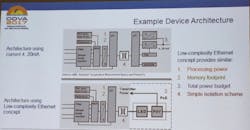Though it’s already technically possible to deliver Ethernet connectivity down to the device and sensor level, it’s not yet practical to do so on a broad scale due to power, space and cost considerations. Sounds like the perfect challenge for device communication engineers to tackle and it’s exactly what the engineers at Analog Devices are working on.
During his session at the ODVA 2017 meeting, Tom Weingartner of Analog Devices said they are looking to bring Ethernet on par with common industrial communications like Controller Area Networks (CANs). To do that, Weingartner said, physical layer changes have to be made to effectively drive down the cost and power issues associated with Ethernet.
In this project to effectively and practically bring Ethernet down to the sensor level, Weingartner noted that it's necessary to deal with the special layout considerations of industrial automation devices, such as numerous high-speed pins and the need for isolation. To address this, Analog Devices is conducting experiments to reduce complexity of Ethernet and is focusing on the development of an advanced Media Access Control (MAC)—the hardware address that identifies each node on a network.
With this approach, “we’ve targeted a small scale, single-chip processing solution (to bring Ethernet to industrial edge devices) by reducing processor speed, memory and RAM size, reducing the interconnection complexity from processor to network interface, and reducing the pin count and complexity of the network interface,” said Weingartner. Essentially, “we’re bringing MAC into the PHY (the physical layer of the OSI model which connects a MAC to a cable), which is what Ethernet is all about. Doing this opens up possibilities not just for new implementations, but for brownfield applications as well.”
Explaining how Analog Devices' idea for an advanced MAC to bring Ethernet to edge devices would work, Weingartner said, “Instead of general traffic filtering, we perform intelligent/dynamic frame filtering and buffering before any frames are communicated to the processor. With this capability, the advanced MAC can manage priorities among protocols. It also reduces the overall buffer space requirements and retains frames based on priority, applications and processor load conditions. By doing this, it substantially reduces (the) amount of data transferred to and processed by processor.”
Weingartner said that reducing the footprint of Ethernet with an advanced MAC approach opens the door to the use of Ethernet over twisted pair and the ability to add power and intrinsic safety to edge-level Ethernet communications. He added that it also allows for Time Sensitive Networking (TSN) to be brought down to the edge.
Three specific impacts of Analog Devices' advanced MAC approach include:
- Device software—which has the biggest impact on complexity. Addressing this aspect is a critical factor because “the software footprint affects memory size and protocols impact processor selection,” said Weingartner.
- Device hardware can be architected to help software manage complexity. “Advanced MACs can reduce the load on software by providing more layer 2 processing,” he said.
- Reallocating the MAC layer into PHY creates opportunities for even the simplest processors to connect to Ethernet networks.
As exciting as this idea sounds, Weingartner stressed that, at this point, Analog Devices' approach to this concept is just that: an approach. “It’s not a done deal yet,” Weingartner said. “Our goal is to reduce the power, area and cost of Ethernet to bring Ethernet to devices that may not even have a MAC.”
By presenting this concept to groups like ODVA, Analog Devices is seeking further input into the concept to help deliver a chip-based product that can address industry’s needs relevant to enabling Ethernet communication on industrial edge devices.
Leaders relevant to this article:


